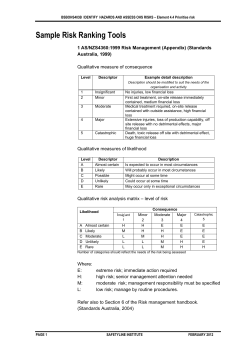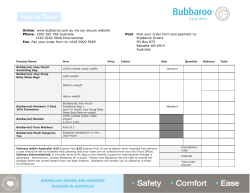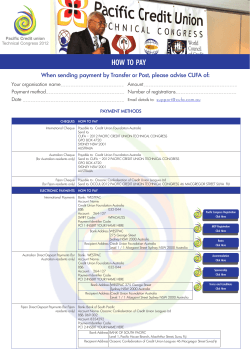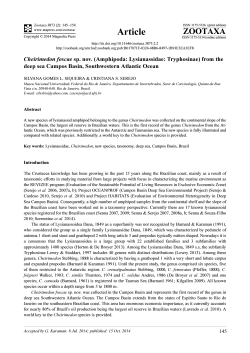
Zoological Catalogue of Australia Crustacea: Malacostraca Eucarida (Part 2) Decapoda—
Zoological Catalogue of Australia Crustacea: Malacostraca Eucarida (Part 2) Decapoda— Anomura, Brachyura Volume 19.3B P J F Davie This book is available from CSIRO PUBLISHING through our secure online ordering facility at http://www.publish.csiro.au/ or from: Customer Service CSIRO PUBLISHING PO Box 1139 Collingwood Victoria 3066 Australia Telephone Freecall Fax Email +61 3 9662 7666 1800 645 051 (Australia only) +61 3 9662 7555 publishing.sales@csiro.au © Commonwealth of Australia 2002 The sample pages following are provided solely for information purposes and may not be reproduced, stored or transmitted in any form or by any means without prior permission of the copyright owner. Contact CSIRO PUBLISHING for all permission requests. Zoological Catalogue of Australia Crustacea: Malacostraca Zoological Catalogue of Australia Crustacea: Malacostraca, by PJF Davie, 2002, CSIRO Publishing, 656 pp. ANOMURA ORDER: ANOMURA INTRODUCTION The infraorder Anomura includes 14 families arranged in four superfamilies: Coenobitoidea (hermit-crabs, and the Hairy Stone Crab—Coenobitidae, Diogenidae, Lomisidae, Pylochelidae, Pylojacquesidae); Paguroidea (stone or king crabs, and other hermit-crabs—Lithodidae, Paguridae, Parapaguridae); Galatheoidea (squat lobsters, porcellain-crabs and allies—Aeglidae, Chirostylidae, Galatheidae, Porcellanidae); and Hippoidea (mole-crabs—Albuneidae, Hippidae). Only the Aeglidae is not represented in Australian waters. Borradaile (1903) included the Thalassinidea within the Anomura, and this view persisted for many years, even into recent literature (e.g. Glaessner 1969; McLaughlin 1980; Williams 1984). Burkenroad (1963) excluded the thalassinids, a move supported by de Saint Laurent (1979), and having wide acceptance since Bowman & Abele’s (1982) ‘Classification of Recent Crustacea’. Within the Paguroidea the traditional concept of evolution held that the lithodid crab-like body form evolved from a typical shell-dwelling hermit crab—a view given modern credence by Cunningham et al. (1992), based on DNA data. However, two recent papers by McLaughlin & Lemaitre (1997, 2000) present convincing evidence from adult and larval morphology, that points to the reverse having occurred, with hermit-crabs having arisen from a lithodid-like ancestor through calcium loss, habitat change, and consequential morphological adaptations. Williamson (1992) and Spears et al. (1992) revived the controversial view that the Dromioidea brachyurans are actually anomurans, although this was disputed subsequently by Scholtz & Richter (1995), and it is not accepted here. The alternative name ‘Anomala’ has often been used for this group. McLaughlin & Holthuis (1985) discussed thoroughly the nomenclatural history of both names, and recommended the use of Anomura on the basis of widest usage, and in the interests of stability of nomenclature. Diagnosis Carapace variable in shape; not fused to epistome. Eyes stalked, compound; generally well developed. Antennules with peduncle 3-segmented; flagella usually paired. Antennal peduncles sometimes with five, possibly six, or fewer segments; exopod usually reduced to acicle; flagellum variable in length. Mandibles with or without palp; molar and incisor processes usually not distinct. Maxillulae with endopodal palp. Maxillae biramous; usually with bilobed endites. Maxillipeds with flagella usually present; sometimes absent from first; often with crista dentata; usually not operculate. First pereiopod usually chelate, second sometimes chelate; fourth and fifth usually chelate or subchelate, one or both frequently reduced. Abdomen with pleopods rarely well developed; often reduced or present only on one side; both sexes sometimes with copulatory structures; uropods often reduced or modified, occasionally absent; telson occasionally reduced or absent; sometimes together with uropods forming tailfan. Segmentation: head with 5 + 3 thoracic (maxillipeds); thorax with 5; abdomen with 6, excluding telson, although segmentation frequently obscured. Sexes separate; gonopores on coxae of third pereiopods of female, on fifth of male; first and/or second pleopods often modified as gonopods in both sexes; female sometimes with abdominal brood pouch; male sometimes with sexual tube(s). (After McLaughlin 1980). References Borradaile, L.A. (1903). On the classification of the Thalassinidea. Ann. Mag. Nat. Hist. 12(7): 534–551, 638 Bowman, T.E. & Abele, L.G. (1982). Classification of Recent Crustacea. pp. 1–27 in Abele, L.G. (ed.) The Biology of Crustacea. Vol. 1. Systematics, the Fossil Record, and Biogeography. New York : Academic Press 23 © Commonwealth of Australia 2002 http://www.publish.csiro.au/ Zoological Catalogue of Australia Crustacea: Malacostraca Zoological Catalogue of Australia Crustacea: Malacostraca, by PJF Davie, 2002, CSIRO Publishing, 656 pp. ANOMURA Burkenroad, M.D. (1963). The evolution of the Eucarida, (Crustacea, Eumalocostraca), in relation to the fossil record. Tulane Stud. Geol. 2(1): 1–17 Cunningham, C.W., Blackstone, N.W. & Buss, L.W. (1992). Evolution of King Crabs from hermit crab ancestors. Nature (Lond.) 355: 539–542 de Saint Laurent, M. (1979). Sur la classification et la phylogénie des Thalassinides: définition des familles des Callianassidae et des Upogebiidae et diagnose de cinq genres nouveaux. C. R. Séances Acad. Sci. 288: 1395–1397 Glaessner, M.F. (1969). Decapoda. pp. R399–R533, R626–R628 in Moore, R.C. (ed.) Treatise on Invertebrate Paleontology. Part R. Arthropoda 4(2) Crustacea (except Ostracoda) Myriapoda — Hexapoda. Laurence, Kansas : The University of Kansas and The Geological Society of America, Inc. Vol. 2 pp. R399–R651 McLaughlin, P.A. (1980). Comparative Morphology of Recent Crustacea. San Francisco : W.H. Freeman & Co. 177 pp. McLaughlin, P.A. & Holthuis, L.B. (1985). Anomura versus Anomala. Crustaceana 47(2): 204–209 McLaughlin, P.A. & Lemaitre, R. (1993). A review of the hermit crab genus Paguritta (Decapoda: Anomura: Paguridae) with descriptions of three new species. Raffles Bull. Zool. 41(1): 1–29 McLaughlin, P.A. & Lemaitre, R. (2000). Aspects of evolution in the anomuran superfamily Paguroidea: one larval prospective. Invert. Reprod. Dev. 38(3): 159–169 Sholtz, G. & Richter, S. (1995). Phylogenetic systematics of the reptantian Decapoda (Crustacea, Malacostraca). Zool. J. Linn. Soc. 113: 289–328 Spears, T., Abele, L.G. & Kim, W. (1992). The monophyly of brachyuran crabs: a phylogenetic study based on 18S rRNA. Syst. Biol. 41: 446–461 Williams, A.B. (1984). Shrimps, lobsters, and crabs of the Atlantic coast of the eastern United States, Maine to Florida. . Washington, DC : Smithsonian Institution Press 550 pp. Williamson, D.I. (1992). Larvae and Evolution. Towards a New Zoology. New York : Chapman & Hall 223 pp. 24 © Commonwealth of Australia 2002 http://www.publish.csiro.au/ Zoological Catalogue of Australia Crustacea: Malacostraca Zoological Catalogue of Australia Crustacea: Malacostraca, by PJF Davie, 2002, CSIRO Publishing, 656 pp. COENOBITIDAE COENOBITIDAE Coenobita perlatus [from Alcock 1905: pl. 14 fig. 2] INTRODUCTION Coenobitids form a small family of circumtropical, semiterrestrial hermit crabs. Adult coenobitids are fully terrestrial, but they still migrate to the sea to release planktonic zoeae. Species of Coenobita are commonly known as ‘land hermit crabs’; and perhaps the best known to Australians is Coenobita variabilis which is often sold in the pet industry under the name of ‘crazy crabs’. The most spectacular member of the family is the Coconut Crab, Birgus latro. It is the largest known land arthropod, growing up to 2.5 kg in weight, and is prized as food where it occurs. This species is not found on the Australian mainland, but is widespread on the more oceanic islands of the tropical Indo-west Pacific, and is abundant on Australian protectorates such as Christmas and Cocos-Keeling Islands in the eastern Indian Ocean. The biology of this species has been reported on by Brown & Fielder (1991). The most important recent work on Australian Coenobita species is that of Harvey (1992), who finally clarified the identity of Coenobita variabilis, and described its larval development. Diagnosis Carapace and body mostly paguroid in form (‘hermit crabs’), or with abdomen calcified and tucked under abdomen (Birgus latro); carapace well calcified. Eyestalks laterally flattened; eyes held subparallel to each other. Antennular peduncles prominently elongate, first segment deflexed; distal two segments slender and cylindrical; dorsal flagellum compressed with tip truncate. Antennae short, laterally compressed; antennal acicle small and usually fused to second peduncular segment. Third maxillipeds approximated basally; ischium with welldeveloped crista dentata; accessory tooth absent. Flagella of exopod of second and third maxillipeds much reduced. Chelipeds massive, left usually larger than right. Walking legs stout, longer than chelipeds. Fourth pereiopod chelate or subchelate; fifth pereiopod chelate. Abdomen bilaterally asymmetrical, segments not clearly marked. Male without unpaired pleopods; female with three unpaired pleopods. Uropods bearing rasp used to grasp gastropod shell (except Birgus). Fourteen paired phyllobranchiae (but only 10 functional); third maxilliped and cheliped each with two paired rudimentary arthrobranchs. 33 © Commonwealth of Australia 2002 http://www.publish.csiro.au/
© Copyright 2025





















